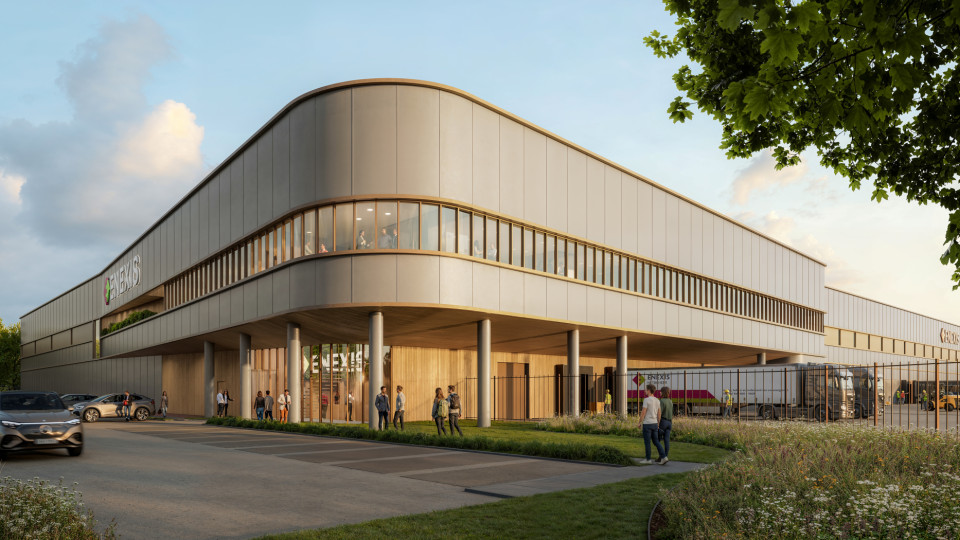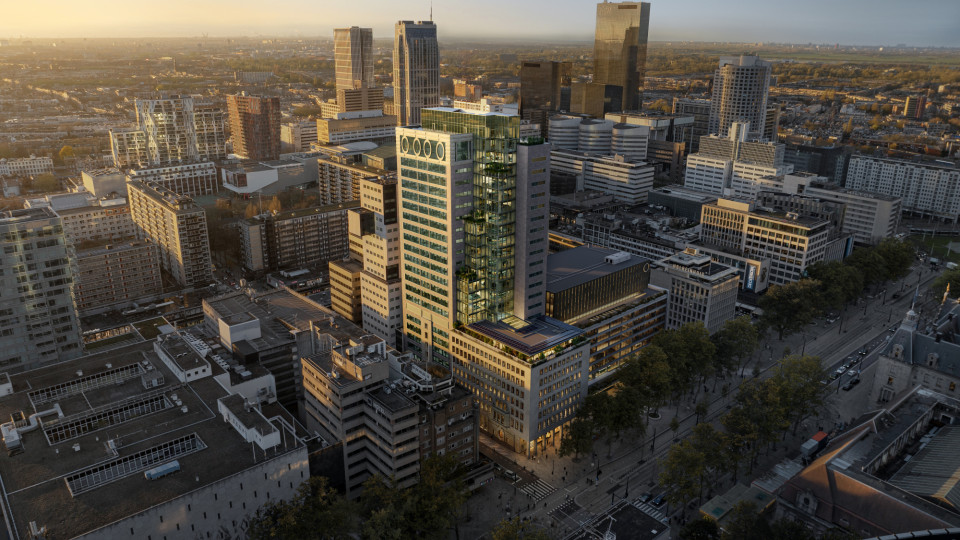New HAVEP building as a symbol of sustainable entrepreneurial vision
In 1865 Hendrik van Puijenbroek founded the company H. van Puijenbroek. With a starting capital of 1,500 guilders he started as a linen salesman. HAVEP has since grown into one of the largest players in the field of durable workwear in the Netherlands. To this day the company is located at the same address where it was founded in 1888. HAVEP asked Paul de Ruiter Architects to provide the family business, after 150 years, with a new building that is in keeping with HAVEP's rich history and sustainable ambitions.
Healthy pavilion in green surroundings
All functions under one roof in a future-proof healthy company building with a nod to the past. That was the wish HAVEP presented to Paul de Ruiter Architects. The Amsterdam based architecture firm specialized in sustainable architecture translated this wish into a circular design with many natural materials which clearly refers to the former company building in terms of form.
The project consists of a main building and a warehouse. By designing two compact volumes that can be partitioned flexibly and multifunctionally, as little precious raw material as possible is needed. The main building of 3,000 m² has a transparent, open and inviting first floor. Here you will find HAVEP's Texperience Center, the workshop and the restaurant. In the Texperience the visitor is taken into the working method of HAVEP of today and the future and the latest sustainable products and services are shown.
The offices are located on the first floor and are connected to the first floor by two round voids. This way all processes and departments are visible from the Texperience Center.
Linked to the main building is the 6,000 m² warehouse. The shape of the roof of the warehouse is based on the shed roofs of the former company building from 1888. This playful design is not only a reference to the past but also provides a perfect sustainable basis: the sloping sides of the shed roof, facing south, are ideal for solar panels while the north side allows daylight into the warehouse without heating the building. With this roof HAVEP provides for its own energy needs in order to achieve a zero-to-meter building.
The warehouse is kept at a constant temperature of 15 degrees by means of underfloor heating. The office is heated and cooled by means of climate ceilings in combination with exterior sun blinds. Both are powered by the energy-efficient air source heat pumps on the roof which can often rely on the Warehouse's solar panels for their power supply.
Water retention crates have been placed under the parking lot around the building to spare the municipal sewer system and to allow rainfall to infiltrate naturally into the soil. The loading pit can be used flexibly as an extra parking space for large events so that fewer parking spaces are needed. This solution has freed up more space for greening around the building.
By making optimal use of daylight, views of the green surroundings and a sophisticated layout with an atrium staircase and voids that stimulates visual connection, movement and meeting, HAVEP's new building also contributes to the well-being of its users. This connection with the environment is continued around the building where the transition from the building to its surroundings is designed as a public park.
Circular wood and biobased materials
HAVEP's new company building is a pioneer in the field of circular construction. The design is as efficient as possible with raw materials and highly focused on saving, reusing and smart use of materials. By looking closely at the lifespan and origin of the materials, the building has a low environmental performance score and thus low environmental impact.
For example, the awning is made of recycled construction parts from the old HAVEP building. The wooden planks on HAVEP's facade come from another special donor building; the characteristic Tripolis buildings on Amsterdam's Zuidas. Tripolis was designed by the famous architect Aldo van Eyck and is currently undergoing a thorough renovation. The strong Iroko wood that van Eyck used in the facades could not be replaced and is now being given a second life in HAVEP's new building.
Iroko wood comes from the African rainforests. For the architectural firm, this is normally a reason not to use the wood anymore. But because of its powerful properties it is extremely suitable for reuse from a donor building. The processing of the donor wood proved to be quite a challenge in practice. To achieve a varied effect, van Eyck had given each Tripolis wall board a slightly different size. In addition, the fact that wood is a living material had to be taken into account so that each board showed its own curvature. To be able to incorporate the donor wood in the design, each facade board had to be fitted in and worked out individually. By working with the existing dimensions and characteristics of the donor wood, HAVEP's circular wooden façade is given the same dynamic effect as van Eyck had in mind for the iconic Tripolis buildings.
The other materials used are mainly biobased and recyclable. The façade is constructed of materials that are 100% recyclable and the supporting structure consists of wood that is prefabricated and demountable. For the facade openings, Accoya wood frames are used, which is an environmentally friendly preserved wood species based on the fast-growing Radiata Pine. The highly effective preservation process means that the wood can withstand weathering for 50 years without the need for a coat of lacquer or paint. After the use phase, the wood is completely biodegradable due to its natural treatment. All this means that the window frames fit in perfectly with the Cradle to Cradle design philosophy.
The office building is made of a timber construction with laminated wooden spruce columns and beams with walls and floors of CLT. The Warehouse is made of full laminated pine wood construction.
Flax blankets were used to a large extent for the insulation of the building. This form of insulation is a natural residual product from the linen industry, with which HAVEP has made use of one of the residual flows from clothing production. Due to the fact that flax itself has a moisture regulating effect, many square meters of plastic vapor barrier were saved during construction.
Flexible and Future-Focused
The new company building of HAVEP is flexible in use. The shape of the building, the construction and the installation system are designed in such a way that changes can easily be made to the building in the future without having to demolish parts.
Project details
Gegevens
| Name and location | Havep - Goirle |
| Total floor area | 9,000 m² |
| Project description | Office and warehouse |
| Start of design | September 2019 |
| Completion | January 2022 |
| Sustainability | Circular design, wooden construction, biobased materials, reuse of facade elements of donor building, optimal use of daylight, healthy working in an office among greenery. |
Ontwerpteam
| Client | VP Capital / HAVEP |
| Project architect | Paul de Ruiter |
| Project team | Joris Korbee, Marieke Sijm, Alex Pieterse, Matthijs Engele, Mark Homminga |
| Construction management | P&H adviseurs |
| Contractor | Hurks & P&H adviseurs |
| Landscape architect | Advies- en Ontwerpbureau Geert Janssen |
| Constructor | Luning ingenieurs |
| Other parties involved | Batenburg - e-installations Megens - w-installations Wijnen - sprinkler installation DENK-W! - installation advice DGMR Engineers - building physics BIS Econocom - interior design Boost Logix - logistics advice VKP - facade construction and assembly Arcon wood constructions - wood construction |

















